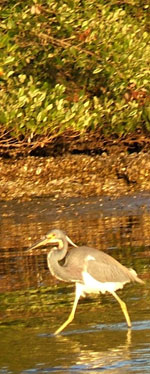Nature Does It Best
So the decades-long experiment has been run—with due time to examine the results produced throughout Sarasota by the windborne seeds. And the results are in: on neither private nor public lands is there an upwelling of new pines. On Siesta Key, which faces Big Edwards Island, there has instead been a decrease in the Pines over recent decades (a severe freeze during the mid 1980’s damaged many of Siesta’s pines).
Does this mean there’s no need for routine efforts at control? No. County crews and volunteers recruited by the county have long monitored beaches, parks and other public lands, pulling out by hand the seedlings of a long list of species, including Brazilian Pepper, Air Potato, Australian Pines, and many others. The rationale for such efforts undoubtedly will continue—in effect, forever. As George Tatge, manager for beaches, parks and trails in the county’s Parks and Recreation Department, explains, new baby shoots continue to sprout even in places where dense clumps of plants such as Brazilian Pepper or the pines have been cut down and cleared away, so the need for repeat control visits is ongoing. Such efforts can also be strengthened, if desired, by adding one or two full-time Park department staff landscaping positions (at about $37,000 per year per person, including overhead, insurance and benefits).
Just give me the simple life…
So the choice is simple. On the one hand, a response to the only criticism that might actually apply to the Big Edwards pines—their seed dispersal—is already in place in Sarasota. There is no new march of Pines that confronts Sarasota, thanks both to nature and the time-honored and simple practice known to every gardener as pulling up the “volunteers.” Simple too is an available upgrade in control efforts, should the county wish to do so: one or two guys with a cloth bag or a tarp, focused solely on baby shoots of all exotic plants, visiting all Gulf beaches and other public lands several times in the course of a year. (And that would cover maintenance visits expected to continue virtually forever to pull up shoots of a dozen other plant species in addition to Australian Pines).

Edwards Island
The other solution is an industrial style dredging project that will replace a natural process of restoration in the Bay with a Disney-style exhibit that offers little benefit to the Bay and a substantial risk of harm to important natural assets. Using the $180,000 per acre figure from Palm Beach’s Snook Natural Area, one could guess the cost to be $1,080,000 for an industrial-type dredging project on the six-acre Big Edwards Island—and that would not eliminate the need for ongoing maintenance visits there and elsewhere (either by existing crews and volunteers, or added spending for one or two positions at roughly $37,000 apiece).
One method does not rely on dredging, guarantees the safety of Roberts Bay’s existing mangroves, oysters, fishing, crabbing and seagrass, makes no permanent changes to flows of Bay currents, permits nature to continue its 50-year-old program of creating inter-tidal habitat on the Bay’s second-largest mangrove island, saves perhaps $1 million (and may cost as little as $0 in total if there’s no need to upgrade present volunteer activities), saves Big Edwards’ beach and shady picnic area, and responds to what actually exists on this particular island in Roberts Bay, rather than to general descriptions drawn up elsewhere or to a bureaucratic grand design. The more humble approach does not pretend to out- create nature, to make irreversible changes to Sarasota’s living bay, to require heavy industry or to use a lot of fossil fuels. And it also supports the property values and property taxes that benefit the entire community, as well as the special look and feel of Roberts Bay.
A preference for the small-scale is a little like acknowledging that there’s no command central, situation room or top-down headquarters for a diffuse natural system such as Sarasota’s living bay, which operates by timeless, natural laws in a growing urban area that has often been an arrogant and inconsiderate neighbor.
In the 21st century, it is a sign of progress for Sarasota to choose the more humble, low key and non-industrial, way. As we cheer Roberts Bay’s recovery, it’s important to remember that Mother Nature knows more than even our best engineers about island restoration in Sarasota’s bays, because she’s been doing it continuously for more than 3,000 years (that’s roughly 1,000 years before the Roman Empire). And when Mother Nature does it, it doesn’t cost taxpayers a penny.
It seems to me that Disney wants our money. What the bay wants from us is to stop putting junk into it—and then to get out of its way.
Kenneth M. Pierce, now retired in Sarasota, FL, began his career in publishing as a journalist, winning awards at Time Magazine, co-founding the Chicago Journalism Review, and editing the Columbia Journalism Review. His past consulting clients include National Wildlife Magazine.